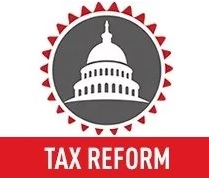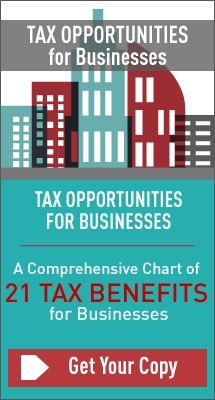 President Trump and Republican congressional leaders turned their attention to tax reform last week by releasing an outline of their long-awaited tax reform plan.
President Trump and Republican congressional leaders turned their attention to tax reform last week by releasing an outline of their long-awaited tax reform plan.
The nine-page “Unified Framework for Fixing Our Broken Tax Code” is intended to serve as a template for the congressional committees to draft legislation to cut tax rates, simplify the tax code and provide a more competitive environment for businesses. It addresses tax issues that affect both individuals and businesses.
Business taxes
Many businesses are likely to see large tax cuts under the framework. Affected areas include:
Corporate tax rate: The framework establishes a corporate tax rate of 20%. According to the outline, this rate is “below the 22.5% average of the industrialized world.” The current rate is 35%, although the effective tax rate after deductions and expenses is 23%.
Pass-through tax rate: Smaller businesses also benefit under the framework. Instead of paying their personal income tax rate (which can currently be up to 39.6%), owners of so-called “pass-through” entities (sole proprietorships, partnerships and S corporations) will pay at a 25% rate.
However, the framework contemplates that Congress “will adopt measures to prevent the recharacterization of personal income into business income to prevent wealthy individuals from avoiding the top personal tax rate.”
Capital investments: Under existing tax law, capital investments generally are depreciated over several years. The framework allows companies to immediately expense such new investments — except buildings constructed after September 27, 2017 — for at least the next five years.
READ MORE: The 10 Top Tax Benefits for Businesses
 Tax credits and deductions: The framework keeps the research credit and the low-income housing credit, but limits the net interest expense deduction claimed by C corporations. It also discards the Section 199 domestic production activities deduction, deeming it unnecessary due to the substantial rate reduction. Numerous other deductions, business credits and special exclusions will be repealed or limited.
Tax credits and deductions: The framework keeps the research credit and the low-income housing credit, but limits the net interest expense deduction claimed by C corporations. It also discards the Section 199 domestic production activities deduction, deeming it unnecessary due to the substantial rate reduction. Numerous other deductions, business credits and special exclusions will be repealed or limited.
Foreign income: The framework envisions a “territorial” taxation system for multinational companies to remove incentives to keep foreign profits and jobs offshore. It begins by exempting foreign profits when repatriated to the United States. It also grants a 100% exemption for dividends from foreign subsidiaries in which the U.S. parent company has at least a 10% stake.
To transition to the new system, all accumulated untaxed offshore earnings will be immediately subject to a one-time tax at a fixed rate. Different rates will apply to money held in cash or cash equivalents (for example, bonds or stocks) and money invested in less-liquid assets, such as factories, with the latter taxed at a lower rate. The tax liability will be spread over “several years.”
Finally, the framework aims to prevent the offshoring of profits to tax havens, and the resulting erosion of the U.S. tax base, by taxing the foreign profits of U.S. multinational corporations at a reduced rate and on a global basis. The congressional committees are instructed to incorporate rules that level the playing field between U.S.-headquartered and foreign-headquartered parent companies.
READ MORE: Attention Businesses: Trump Administration Signals Employer-Friendly Shift
Individual taxes
The framework proposes several changes to the existing tax laws for individual taxpayers, including:
Tax rates: The framework reduces the number of tax rates from the current seven to three — 12%, 25% and 35%. The highest rate now is 39.6%. The framework does, however, provide that Congress can add a fourth bracket above 35% to ensure the new tax code is “at least as progressive as the current system and does not shift the tax burden from high-income to lower- and middle-income taxpayers.” The framework doesn’t specify the income levels that will trigger each of the three rates, but it contemplates using a more accurate measure of inflation to index the tax brackets and other tax parameters.
Estate tax and generation-skipping transfer (GST) tax: For 2017, the 40% top estate tax rate applies to estates that exceed the $5.49 million gift and estate tax exemption. The 40% top GST tax rate applies to bequests or gifts that are made to beneficiaries who are more than one generation below the giver and that exceed the $5.49 million GST tax exemption. The framework repeals both of these taxes.
Personal exemptions and standard deductions: Perhaps the most significant change for individual taxpayers is in this area. For 2017, the personal exemption is $4,050; the standard deduction is $6,350 for single taxpayers and married couples filing separately and $12,700 for married couples filing jointly. Under the proposed framework, the personal exemption is eliminated, and the standard deduction is $12,000 for singles and married couples filing separately and $24,000 for married couples filing jointly. In other words, it consolidates the personal exemption and the standard deduction into a larger deduction.
Child tax credit: The framework promises a “significant increase” in the child tax credit (currently $1,000 per child) but doesn’t specify an amount. It also will increase the income levels at which the credit begins to phase out (currently $75,000 for single parents and $110,000 for married couples filing jointly), making the credit available to more families and eliminating the current “marriage penalty.” And the framework provides a nonrefundable $500 credit for nonchild dependents to help offset the expense of caring for other dependents.
Deductions: The deductions available to individual taxpayers will undergo numerous changes. The framework eliminates most itemized deductions but retains the mortgage interest and charitable contribution deductions. (No explicit reference is made to deductions for state and local taxes). It also retains tax incentives for work, higher education and retirement savings, but encourages Congress to simplify such benefits.
Alternative minimum tax (AMT): This tax was intended to ensure that high-income taxpayers pay at least a minimum amount of tax. Over the years, it has ensnared more and more middle-income taxpayers. The framework eliminates the AMT.
Stay tuned
The framework covers many tax issues but paints with a broad brush. It will be up to the House Ways and Means Committee and the Senate Finance Committee to hash out the details, and lawmakers are certain to encounter a range of budgetary and political hurdles that might delay the process. The result could be legislation that differs in some substantial ways from those outlined in this framework.
© 2017





